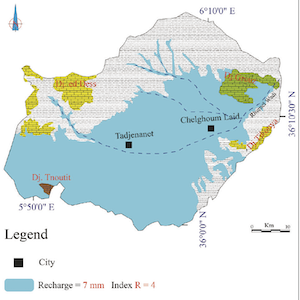Assessment of groundwater vulnerability to pollution using DRASTIC and the SI methods: case of the alluvial aquifer in Tadjenanet-Chelghoum laid (East Algeria)

All claims expressed in this article are solely those of the authors and do not necessarily represent those of their affiliated organizations, or those of the publisher, the editors and the reviewers. Any product that may be evaluated in this article or claim that may be made by its manufacturer is not guaranteed or endorsed by the publisher.
Accepted: 16 May 2023
Authors
The region of Chelghoum Laid - Tadjenanet is located in the east of Algeria in the high southern plains of Setif, characterized by a highly vulnerable shallow alluvial aquifer. The vulnerability of groundwater to pollutants is a relative concept, not measurable or dimensional. The nature, quality, and reliability of used data used have a major impact on the correctness of its assessment. Its classification is usually based on the estimation of many more or less essential factors, such as the characteristics of soil and unsaturated zone, the saturated zone, the recharge , the topography and the hydraulic conductivity. The vulnerability of the aquifer to pollution was investigated using two intrinsic vulnerability methods: DRASTIC and susceptibility index (SI). SI method is an adaptation of the DRASTIC specifically design for nitrate-based pollution. The parameters used as input data are, among others, the depth of the groundwater, the soil type, the topographic slope and the groundwater recharge. The validity of the two methods for assessing the vulnerability to nitrates was established by comparing the distribution of these elements in groundwater with the distribution of the various vulnerability classes. GIS techniques were used to implement these methods. Vulnerability maps created using the DRASTIC and SI method’s depict the potential for pollutants to penetrate and spread in these locations depending on the terrain encountered on the surface and the depth of the aquifer. The comparison revealed that the SI technique is the most accurate in the studied alluvial aquifer. The establishment of the pollution vulnerability map highlighted an area of great vulnerability in the center of the plain, reflected by the fragility of the soil and the shallow depth of the water. While the average vulnerability areas are in the center, and east at the periphery of Wadi Rhumel, the rest of the field is slightly vulnerable. The vulnerability and contamination risk maps created for this study are valuable tools for environmental planning and can be used for predictive management of groundwater resources. This case study suggests that the approach may be applicable to other areas as part of efforts to target groundwater management efforts.
How to Cite

This work is licensed under a Creative Commons Attribution-NonCommercial 4.0 International License.








